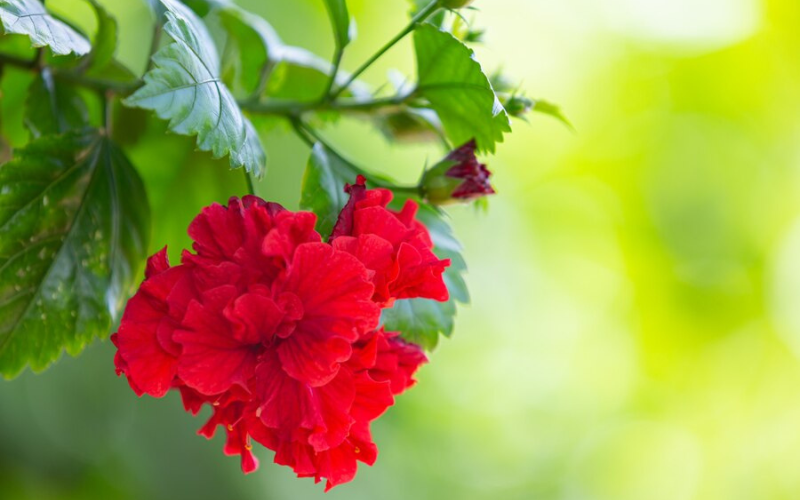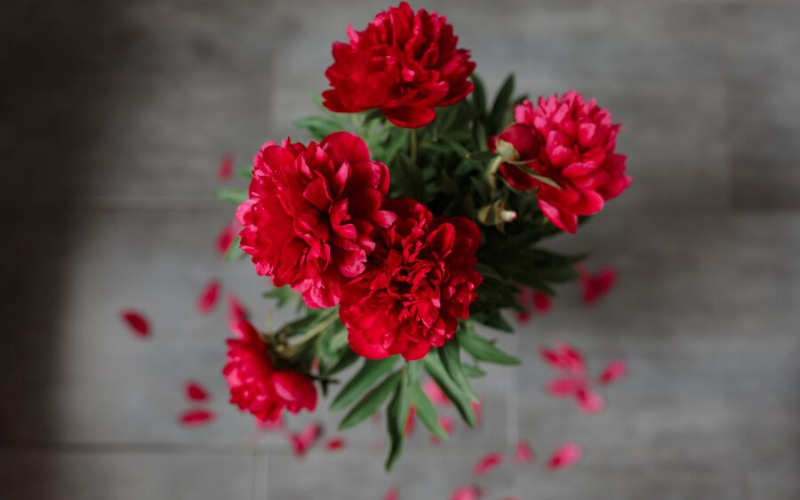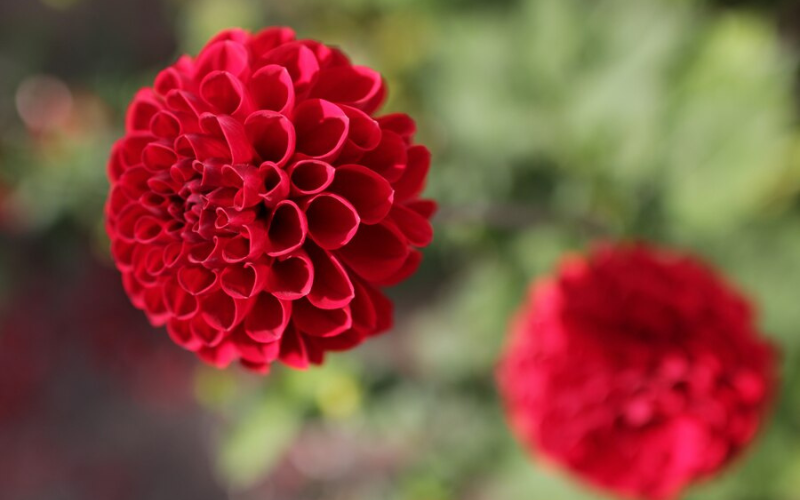Introduction to the Beauty and Symbolism of Red Flowers
Vibrant and appealing, red flowers are special in the world of flora because of their deep symbolic meaning in addition to their striking beauty. Stories of passion, love, and deep meaning have been told about red flowers for generations, from the flaming appeal of poppies to the petals of growing roses.

Roses: The classic Symbol of Love and Passion
Roses are the ultimate representation of passion and love, with their smooth petals and tempting scent. Deep love and passionate love are represented by these ageless flowers, which have survived centuries and cultural shifts to become a part of the fabric of human emotions.

Tulips: Vibrant red blooms that signify perfect love
Tulips are one of the most popular flowers in the world because of their graceful and colorful blooms. Though tulips are available in many colors, red tulips are particularly meaningful as they represent intense passion and perfect love. With their unusual cup-shaped petals and thin stems, these alluring flowers express grace and transmit feelings that are above and beyond the norm.

Poppy: A Striking and Symbolic Red Flower
The poppies, with their eye-catching red petals and delicate, papery texture, are flowers with deep cultural and historical significance. In addition to being visually appealing, the red poppies represent dedication, remembering, and the connection between life and death.

Geranium: A Versatile Red Flower for Gardens and Containers
With their vivid red blooms, geraniums are loved for their eye-catching appearance as well as their adaptability to container gardening and garden landscapes. Gardening enthusiasts love these hardy and low-maintenance plants because they bring a flash of color to outdoor areas.

Carnation: A Traditional Red Flower with Various Meanings
Carnations are classic flowers that have been loved for ages because of their fluttery petals and popular scent. Though it comes in a variety of colors, the red carnation, in particular, has a unique position in history as a classic flower with a wealth of symbolic significance.

Hibiscus: Exotic red blooms that evoke tropical vibes
The exotic and vivid red flowers of the hibiscus flower inspire quick visions of tropical paradises and warm, sunny environments. The red hibiscus, known for its huge, showy flowers and striking appearance, is not only a visual feast but also a representation of female identity, beauty, and the carefree charm of tropical environments.

Dahlias: Bold and Beautiful Red Blossoms in Various Shapes
Gardeners love dahlias for their broad diversity of shapes, sizes, and vibrant colors, as well as their bold and gorgeous red flowers. These beautiful native Mexican flowers have gained popularity in gardens all around the world for their dramatic and elegant red flowers.

Tips for Growing and Caring for Red Flowers
Select the Right Varieties: Choose red flower varieties that are well-suited to your climate, soil type, and sunlight conditions. Different plants have varying requirements, so it’s essential to pick those that grow in your specific environment.
Soil Preparation: Ensure your soil is well-draining and enriched with organic matter. Red flowers generally prefer slightly acidic to neutral soil conditions. Regularly amend the soil with compost to improve fertility and texture.
Sunlight Requirements: Most red flowers thrive in full sunlight. Ensure they receive the recommended amount of sunlight for optimal growth and blooming. However, be aware of specific plant needs, as some varieties may tolerate partial shade.
Watering: Consistent and adequate watering is crucial. Keep the soil evenly moist, especially during the growing season. However, be cautious of overwatering, as it can lead to root rot. Use mulch to help retain moisture and regulate soil temperature.
Fertilizing: Red flowers generally benefit from regular feeding during the growing season. Use a balanced, water-soluble fertilizer to promote healthy growth and vibrant blooms.
Pruning and Deadheading: Regular pruning and deadheading help promote continuous blooming. Remove spent flowers to encourage the plant to redirect energy towards producing new buds. Prune for shape and size as needed, but avoid heavy pruning during the flowering season.
Disease and Pest Control: Keep an eye out for common pests and diseases that may affect your red flowers. Use organic or chemical treatments as necessary, and promptly address any issues to prevent the spread of problems.
Support and Staking: Some red flowers, particularly those with large blooms, may require support or staking to prevent them from bending or breaking.
Mulching: Mulch around the base of your red flowers to suppress weeds, retain moisture, and regulate soil temperature.
Overwintering: If you’re growing perennial red flowers, consider their specific overwintering needs. Some may require protection from frost, while others benefit from a layer of mulch to insulate the soil and roots.
Regular Inspections: Periodically inspect your red flowers for signs of stress, disease, or pests. Early detection allows for prompt intervention and helps maintain the health and vigor of your plants.

Fun Facts about Red Flowers
Symbol of Love and Passion: Red flowers are often associated with love, passion, and desire. The vibrant color has a universal appeal and is a popular choice for romantic occasions and expressions of deep emotions.
Attracts Pollinators: Many red flowers, such as roses, tulips, and poppies, are not only visually striking but also attract pollinators like bees and butterflies. The bold color helps in catching the attention of these essential insects.
Cultural Significance: In various cultures, red flowers hold significant meanings. For example, in Chinese culture, red is considered a symbol of good luck and prosperity. Red flowers are often used in celebrations and festive occasions.
Edible Red Flowers: Some red flowers are edible and used in culinary applications. Examples include hibiscus, which is often used in teas, and nasturtiums, which have a peppery flavor and can be used in salads.
Poinsettias and Christmas: The vibrant red leaves of poinsettias are synonymous with the holiday season, especially Christmas. In many cultures, they are used as decorative elements during festive celebrations.
Variety of Shades: Red flowers come in a wide range of shades, from deep crimson and scarlet to lighter hues like pink and coral. This diversity allows for a broad spectrum of choices when selecting flowers for different occasions or settings.
Adaptation to Different Climates: Many red flowers have adapted to various climates around the world. For instance, the red hot poker plant (Kniphofia) is known for thriving in diverse environmental conditions.
Historical and Mythical Significance: Red flowers have appeared in historical and mythical contexts. In ancient Greek mythology, for example, the red anemone flower is said to have sprung from the blood of Adonis, symbolizing love and loss.
Red Roses and Romance: Red roses are arguably the most iconic red flowers and are internationally recognized as a symbol of love and romance. They have been used for centuries in literature, and art, and as gifts to convey deep emotions.
Longevity of Red Color: The color red tends to retain its vibrancy longer than many other flower colors. This endurance adds to the visual appeal of red flowers in gardens and floral arrangements.

Name of Red Colour Flowers
Conclusion
Whether you’re planning a garden, selecting flowers for an event, or simply enjoying the beauty of nature, the world of red flowers offers a rich tapestry of options, each with its unique charm and significance. Embrace the passion and elegance that red blooms bring to every corner of your botanical endeavors.
